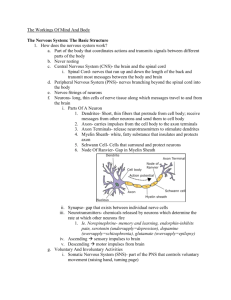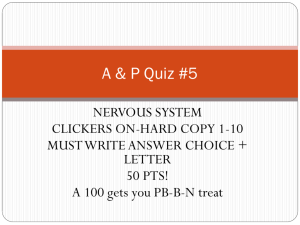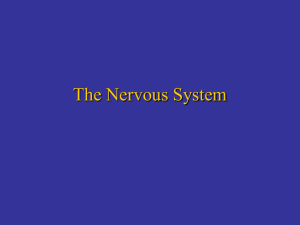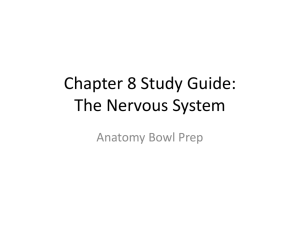Final powerpoint - Humanbodyproject
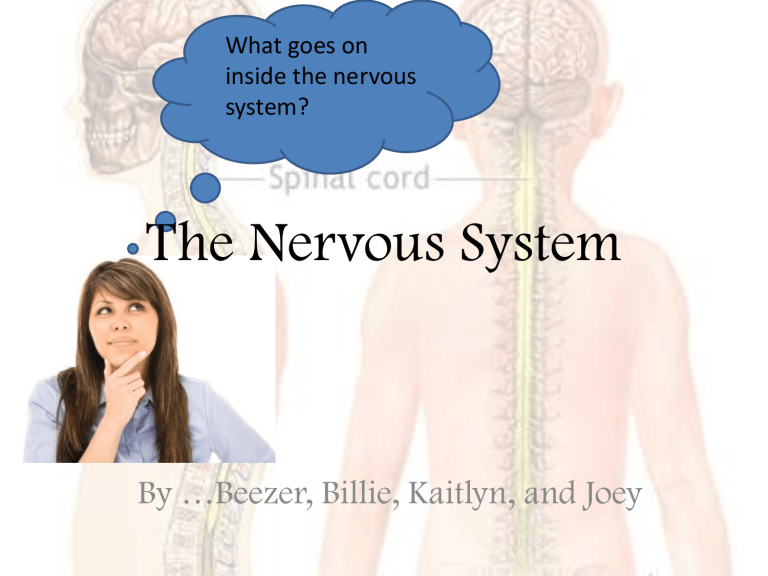
What goes on inside the nervous system?
The Nervous System
By …Beezer, Billie, Kaitlyn, and Joey
Nervous Systems
•
Central nervous system(CNS) – includes your brain and spinal cord. It processes messages.
•
Peripheral nervous system – consists of nerves which connect everything to the CNS
Nervous System Vocabulary
•
Neurons – transfer messages throughout your body using electrical energy.
•
Impulses – the electrical messages that pass along neurons.
•
Dendrites – extensions of neurons by which the neurons receive information.
Nervous System Vocabulary
•
Axon – a fiber that transmits information to other neurons
Central Nervous System
•
The CNS works close with the PNS.
•
It gets information from the sensory neurons and gives messages to various parts of the body and motor neurons.
The Peripheral Nervous System
•
The structure of the neuron starts with the axons which breaks into axon terminals, connects to dendrites which connect to the cell body which protects the nucleus.
•
Neurons have a cell body, dendrites, and axons.
•
A neuron has many dendrites, allowing it to receive impulses from many other cells.
The Brain
Vocabulary
•
Brain: The biggest organ in the nervous system.
•
Involuntary: Processes that the brain controls automatically.
•
Voluntary: Activities controlled by your nerves and brain.
•
Cerebrum: The largest part of the brain where your thoughts and memories are stored.
•
Hemispheres: The two halves of the cerebrum.
•
Medulla: The part of the brain that connects to the spinal cord that controls blood pressure, heart rate, involuntary breathing, and other involuntary activities.
•
Cerebellum: The second largest part of the brain that controls the body’s position.
Cerebrum
•
The largest part of your brain.
•
Voluntary.
•
Memories and thoughts are stored there.
Cerebellum
•
The second largest part of the brain.
•
Keeps track or the body’s position.(balance)
•
Located right below the cerebrum.
Medulla
•
Connects to spinal cord.
•
Small.
•
Controls heart rate.
•
Blood pressure.
•
Involuntary breathing and other involuntary activities.
The Nerves
Nerve Vocabulary
•
Nerves – Axons bundled together with blood vessels and connective tissue.
•
Motor neurons- a neuron that sends impulses from the brain and spinal cord to other systems.
• Reflex – A quick involuntary action that allows you to move before the information reaches your brain.
Nerves
•
Nerves connect CNS to the body
•
Nerves extend throughout the body.
•
Most of the nerves contain the axons of both sensory and motor neurons.
•
The structure of the nerve starts with the spinal cord and connects to the nerves, goes to the axon, to the axon terminal and ends with the muscle fiber.
Spinal Cord
Vocabulary
•
Impulses- the electrical messages that pass along the neurons.
•
Receptors- specialized dendrites that detect changes inside and outside the body.
•
Nerves- axons bundled together with blood and connective tissue.
•
Brain- part of your central nervous system, is the nervous system’s largest organ.
Vocabulary
Neurons- specialized cells that transfer messages throughout the body in the form of fast-moving electrical energy.
Reflex-a quick, involuntary action
Vertebra
•
Bones that surround the spinal cord that are there to help protect it.
Receptors
•
Receptors are sensory neurons that detect changes inside and outside the body.
Receptors
•
Receptors are sensory neurons that detect changes inside and outside the body.
Fun Facts
•
There are about 100 billion neurons in the brain.
•
The Nervous System can transmit impulses as fast as 100 meters per second.
• The right half of the brain controls imagination and creativity, while the left half controls speaking, reading, writing, and solving problems.
• The brain is actually made up of 75% water.
Thank you for your attention. We made this
PowerPoint especially for you! Yes you! We really wanted you to learn about the nervous system so we were very excited to make this.
Now if you didn’t enjoy this PowerPoint then your missing out! The nervous system is too cool, and if you didn’t like it then well…that’s not very nice. The nervous system is VERY sad…=(….see look how sad it is! But if you
LIKED it well then that’s a whole new story that we can’t get into because I’m running out of space on this Slide…awwww! Well bye!!!




